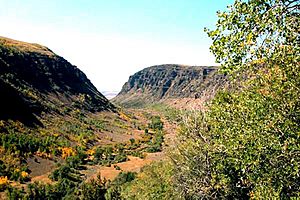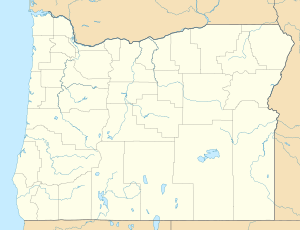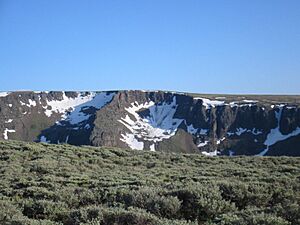Little Blitzen River facts for kids
Quick facts for kids Little Blitzen River |
|
|---|---|

Little Blitzen U-Shaped Gorge
|
|
|
Location of the mouth of Little Blitzen River in Oregon
|
|
| Country | United States |
| State | Oregon |
| County | Harney |
| Physical characteristics | |
| Main source | Steens Mountain Little Blitzen Gorge, Harney County, Oregon 8,975 ft (2,736 m) 42°40′33″N 118°34′56″W / 42.67583°N 118.58222°W |
| River mouth | Donner und Blitzen River near Riddle Ranch, Harney County, Oregon 4,862 ft (1,482 m) 42°40′26″N 118°47′37″W / 42.67389°N 118.79361°W |
| Length | 12.5 mi (20.1 km) |
The Little Blitzen River is a small river, about 12.5-mile (20.1 km) long, in the state of Oregon in the United States. It's a branch of the Donner und Blitzen River. The name "Donner und Blitzen" comes from German words meaning "thunder and lightning." Soldiers gave it this name in 1864. The Little Blitzen River's name might make you think of one of Santa Claus's reindeer!
This river starts high up on the west side of Steens Mountain. This is about 20 miles (32 km) southeast of a town called Frenchglen. It flows through a deep, narrow canyon. The Little Blitzen River joins another river, the South Fork Donner und Blitzen River. Together, they form the main Donner und Blitzen River. This larger river then flows north into Malheur Lake.
Because of its special natural beauty, the Little Blitzen River is part of the National Wild and Scenic Rivers System. This means it is protected by the U.S. Congress. It's also part of the first reserve in the country for a special fish called the Great Basin redband trout. The Little Blitzen Gorge Trail, which follows the river, is known as one of America's "hidden gems" for hiking.
Contents
How the Little Blitzen Gorge Was Formed
The Little Blitzen River flows through a huge, U-shaped valley called the Little Blitzen Gorge. This gorge is one of four similar valleys on the west side of Steens Mountain. These valleys were carved out by giant sheets of ice during the last ice age.
Steens Mountain: A Fault-Block Mountain
Steens Mountain is a very long mountain, about 30 miles (48 km) in length. It's the biggest fault-block mountain in the northern Great Basin area. A fault-block mountain forms when large cracks, or "faults," in the Earth's crust cause huge blocks of rock to lift up or drop down.
The eastern side of Steens Mountain is very steep, almost like a wall. But the western side slopes more gently. The canyons on the western side, like the Little Blitzen Gorge, are cut through basalt rock. These canyons can be as deep as 1⁄2 mile (0.80 km). The Little Blitzen River starts very high up, around 9,000 feet (2,700 m) above sea level. By the time it reaches its mouth, it has dropped about 4,000 feet (1,200 m) in elevation.
Protecting the Little Blitzen River
Much of the land around the Little Blitzen River is part of the Steens Mountain Cooperative Management and Protection Area (CMPA). This area was created in 2000 to keep the natural environment healthy for a long time. The CMPA covers about 425,000 acres (172,000 ha) of public land. The Bureau of Land Management (BLM) and the Steens Mountain Advisory Council help manage it.
Special Protected Areas
About 100,000 acres (40,000 ha) along the top of Steens Mountain are protected as "livestock-free wilderness." This means no farm animals are allowed there. The Little Blitzen Research Natural Area (RNA) is another protected spot. It's 2,540 acres (1,030 ha) big and is located at the top of the Little Blitzen Gorge.
The RNA protects different kinds of ecosystems, both on land and in the water. It also protects special plants. These include the wedgeleaf saxifrage, Steens Mountain whitlow grass, and Davidson's penstemon.
Home for Redband Trout
The Donner und Blitzen river system, which includes the Little Blitzen River, is home to a unique group of Great Basin redband trout. These fish are very special and are protected in the first-ever redband trout reserve in the country. This reserve includes the public lands along the Donner und Blitzen River and its smaller rivers. It covers the areas where these redband trout live now and where they might live in the future.
Fun Things to Do at Little Blitzen River
The Little Blitzen River is a National Wild and Scenic River. This special title applies to the Donner und Blitzen River and all its main branches. It covers the area from where the rivers start down to the southern edge of the Malheur National Wildlife Refuge.
There are many fun things you can do along the river. You can watch for wildlife, go camping, try fishing, or enjoy hiking. If you like to fish, the Oregon Department of Fish and Wildlife has a rule for Little Blitzen River. You must release any fish you catch back into the water.
The Little Blitzen Gorge Trail is especially famous. It's known for its beautiful wildflowers and waterfalls. The American Hiking Society and American Rivers have called it one of the "Ten Hidden Gems of the National Landscape Conservation System."



